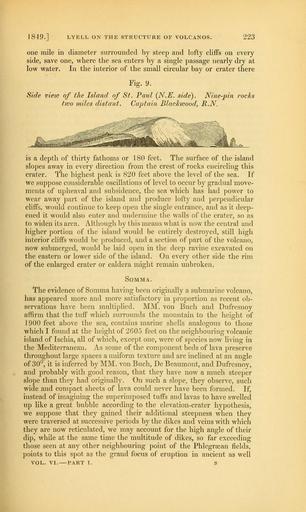MAKE A MEME
View Large Image

| View Original: | The_Quarterly_journal_of_the_Geological_Society_of_London_(13365328653).jpg (1239x2073) | |||
| Download: | Original | Medium | Small | Thumb |
| Courtesy of: | commons.wikimedia.org | More Like This | ||
| Keywords: The Quarterly journal of the Geological Society of London (13365328653).jpg 1849 LYELL ON THE STRUCTURE OF VOLCANOS 223 <br> one mile in diameter surrounded by steep and lofty cliffs on every <br> side save one where the sea enters by a single passage nearly dry at <br> low water In the interior of the small circular bay or crater there <br> Fig 9 <br> Side view of the Island of St Paul N E side Nine-pin i ocks <br> two miles distant Captain Blackwood R N <br> is a depth of thirty fathoms or 180 feet The surface of the island <br> slopes away in every direction from the crest of rocks encircling this <br> crater The highest peak is 820 feet above the level of the sea If <br> we suppose considerable oscillations of level to occur by gradual move- <br> ments of upheaval and subsidence the sea which has had power to <br> wear away part of the island and produce lofty and perpendicular <br> cliffs would continue to keep open the single entrance and as it deep- <br> ened it would also enter and undermine the walls of the crater so as <br> to widen its area Although by this means what is now the central and <br> higher portion of the island would be entirely destroyed still high <br> interior cliffs would be produced and a section of part of the volcano <br> now submerged would be laid open in the deep ravine excavated on <br> the eastern or lower side of the island On every other side the rim <br> of the enlarged crater or caldera might remain unbroken <br> SOMMA <br> The evidence of Somma having been originally a submarine volcano <br> has appeared more and more satisfactory in proportion as recent ob- <br> servations have been multiplied MM von Buch and Dufresnoy <br> affirm that the tuff which surrounds the mountain to the height of <br> 1900 feet above the sea contains marine shells analogous to those <br> which I found at the height of 2605 feet on the neighbouring volcanic <br> island of Ischia all of which except one were of species now living in <br> the Mediterranean As some of the component beds of lava preserve <br> throughout large spaces a uniform texture and are inclined at an angle <br> of 30° it is inferred by MM von Buch De Beaumont and Dufresnoy <br> and probably with good reason that they have now a much steeper <br> slope than they had originally On such a slope they observe such <br> wide and compact sheets of lava could never have been formed If <br> instead of imagining the superimposed tuffs and lavas to have swelled <br> up like a great bubble according to the elevation-crater hypothesis <br> we suppose that they gained their additional steepness when they <br> were traversed at successive periods by the dikes and veins with which <br> they are now reticulated we may account for the high angle of their <br> dip while at the same time the multitude of dikes so far exceeding <br> those seen at any other neighbouring point of the Phlegrsean fields <br> points to this spot as the grand focus of eruption in ancient as well <br> VOL VI PART I S 36934074 113689 51125 Page 223 Text v 6 http //www biodiversitylibrary org/page/36934074 1850 Geological Society of London Biodiversity Heritage Library The Quarterly journal of the Geological Society of London v 6 1850 Geology Periodicals Smithsonian Libraries bhl page 36934074 dc identifier http //biodiversitylibrary org/page/36934074 smithsonian libraries Information field Flickr posted date ISOdate 2014-03-23 Check categories 2015 August 26 CC-BY-2 0 BioDivLibrary https //flickr com/photos/61021753 N02/13365328653 2015-08-26 12 02 02 cc-by-2 0 PD-old-70-1923 The Quarterly journal of the Geological Society of London 1850 Photos uploaded from Flickr by Fæ using a script | ||||